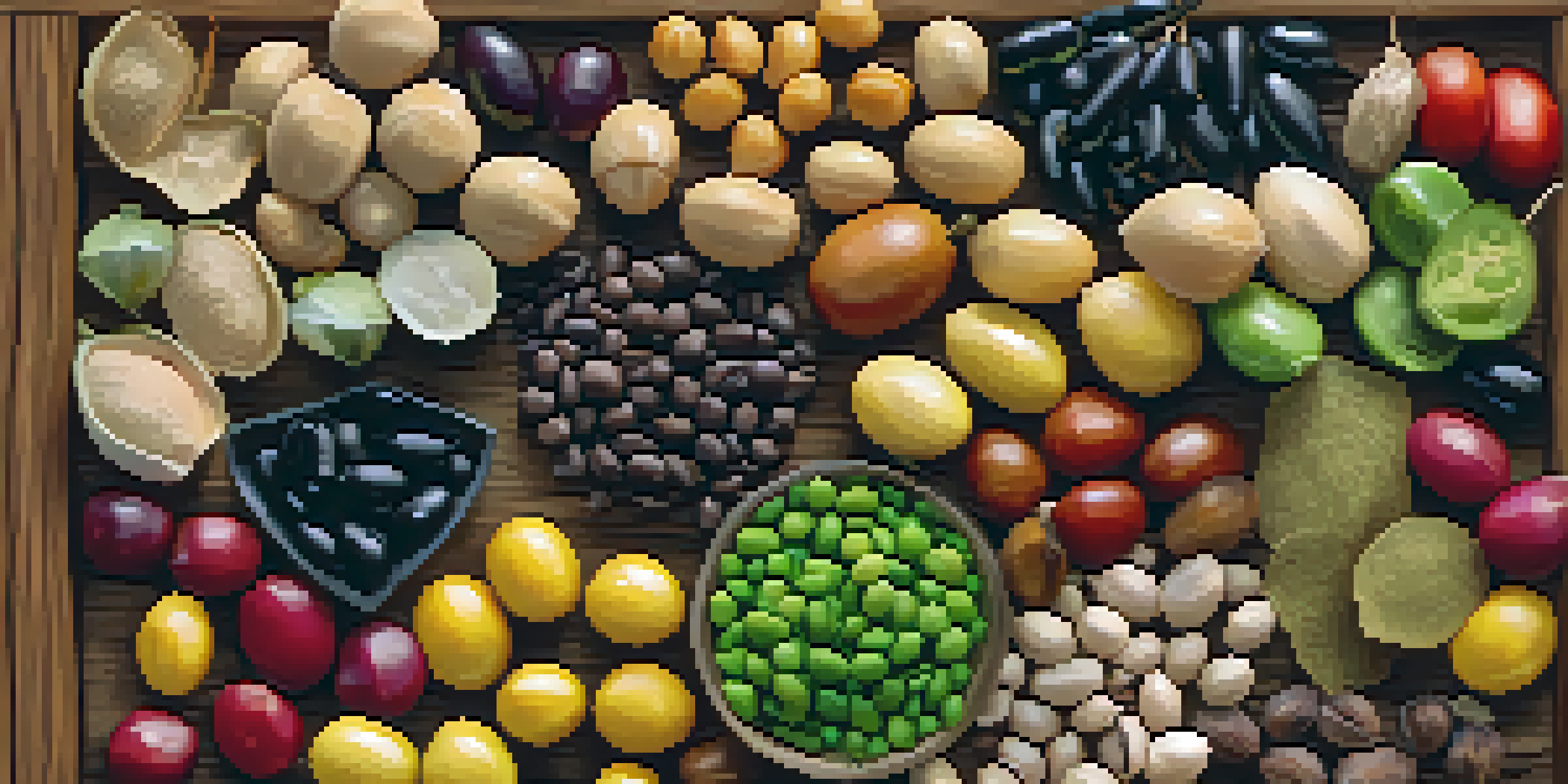Comparing Plant-Based Protein: Legumes vs. Nuts and Seeds

Understanding Plant-Based Proteins: An Overview
Plant-based proteins have gained popularity for their health benefits and environmental sustainability. They come from a variety of sources, primarily legumes, nuts, and seeds. Each of these categories offers unique nutritional profiles and flavors, making it essential to understand their differences.
Let food be thy medicine and medicine be thy food.
Legumes, which include beans, lentils, and peas, are rich in fiber and essential nutrients. Nuts and seeds, on the other hand, provide healthy fats along with protein. This article aims to explore the nuances of these protein sources to help you make informed dietary choices.
Related Resource
By comparing legumes with nuts and seeds, we can uncover the advantages each has to offer. Whether you're a long-time vegetarian or just looking to incorporate more plant-based options into your meals, understanding these proteins is crucial for a balanced diet.
What Are Legumes and Their Nutritional Benefits?
Legumes are a versatile group of plants that include a variety of beans, lentils, and chickpeas. They are packed with protein, making them an excellent choice for those looking to increase their protein intake without relying on animal products. Additionally, legumes are high in fiber, which aids digestion and promotes a feeling of fullness.

On top of that, legumes are low in fat and have a low glycemic index, making them beneficial for maintaining stable blood sugar levels. Their rich nutrient profile includes essential vitamins and minerals such as iron, potassium, and folate. This makes legumes not only a protein source but also a powerhouse of nutrition.
Legumes: High in Protein & Fiber
Legumes, such as beans and lentils, are excellent sources of protein and fiber, making them ideal for a nutritious diet.
Furthermore, legumes are incredibly versatile in cooking. You can use them in salads, soups, and even desserts, proving that healthy eating doesn’t have to be boring. Incorporating a variety of legumes into your diet can enhance flavors while boosting your health.
Nuts and Seeds: Nutritional Powerhouses
Nuts and seeds, including almonds, walnuts, chia seeds, and flaxseeds, are often celebrated for their health benefits. They are rich in healthy fats, specifically unsaturated fats, which can help improve heart health. Additionally, they provide a good amount of protein, making them a great snack or meal addition for anyone looking to diversify their protein sources.
The doctor of the future will no longer treat the human frame with drugs, but rather will cure and prevent disease with nutrition.
Not only are nuts and seeds high in protein and healthy fats, but they also contain essential nutrients like magnesium, vitamin E, and antioxidants. These nutrients contribute to various health benefits, such as reducing inflammation and supporting brain health. This makes nuts and seeds a valuable addition to a balanced diet.
Related Resource
Moreover, their crunchy texture and rich flavors can elevate any dish, from salads to smoothies. Whether you enjoy them raw, roasted, or as nut butter, they can easily fit into your daily meals, providing both taste and nutrition.
Protein Content: A Comparison of Legumes vs. Nuts and Seeds
When it comes to protein content, legumes generally offer a higher protein-to-calorie ratio compared to nuts and seeds. For instance, a cup of cooked lentils provides about 18 grams of protein, while a handful of almonds (about 23 almonds) offers around 6 grams. This makes legumes an excellent option for those looking to maximize their protein intake without consuming too many calories.
On the flip side, nuts and seeds also pack a punch when it comes to protein, but they come with higher fat content. This means while they are nutrient-dense, they can be calorie-heavy if consumed in large quantities. Hence, portion control becomes key when incorporating nuts and seeds into your diet.
Nuts and Seeds: Healthy Fats
Nuts and seeds provide essential healthy fats and nutrients that support heart and brain health.
Ultimately, the choice between legumes and nuts/seeds may come down to your dietary needs and preferences. If you’re focusing on lower-calorie options, legumes might be your go-to. However, if you’re looking to add healthy fats and a bit more crunch, nuts and seeds are ideal.
Fiber Content: The Digestive Benefits of Legumes
One of the standout features of legumes is their high fiber content. A cup of cooked black beans contains around 15 grams of fiber, significantly more than most nuts and seeds. Fiber is crucial for digestive health, helping to regulate bowel movements and prevent constipation.
In addition to aiding digestion, fiber can also help manage cholesterol levels and stabilize blood sugar. This can be particularly beneficial for individuals with diabetes or those looking to maintain a healthy weight. As a result, incorporating legumes into your meals can provide long-lasting benefits for your gut health.
Related Resource
While nuts and seeds do contain fiber, they generally have less than legumes. However, they still contribute to overall fiber intake and can complement a diet rich in whole foods. Balancing both legumes and nuts/seeds can offer a well-rounded approach to nutrition.
Healthy Fats: The Benefits of Nuts and Seeds
Nuts and seeds are renowned for their healthy fat content, particularly omega-3 and omega-6 fatty acids. These fats are essential for brain health and can help reduce inflammation in the body. For example, chia seeds are a fantastic source of omega-3s, making them a great addition to smoothies or oatmeal.
In contrast, legumes are low in fat, which can be an advantage for those seeking to reduce their overall fat intake. However, not all fats are created equal, and the healthy fats found in nuts and seeds contribute to heart health and overall well-being. Including a variety of fat sources in your diet is essential for maintaining optimal health.
Balancing Protein Sources
Incorporating both legumes and nuts/seeds into your meals can offer a well-rounded approach to nutrition.
Thus, while legumes provide a protein and fiber boost, nuts and seeds offer healthy fats that can enhance your meals. Finding the right balance between these food groups can help you achieve a nutritious diet tailored to your health goals.
Incorporating Legumes, Nuts, and Seeds into Your Diet
Incorporating legumes, nuts, and seeds into your diet can be both easy and delicious. Start by adding chickpeas or black beans to salads and grain bowls for an extra protein kick. You can also blend nuts into smoothies for a creamy texture or sprinkle seeds on top of yogurt for added crunch.
Experimenting with different recipes can make it fun to include these protein sources in your meals. For instance, try making a lentil soup, a nut-based pesto, or an oatmeal topped with chia seeds. The possibilities are endless, and you can discover new flavors and textures along the way.

Ultimately, the key is to enjoy a balanced diet that incorporates a variety of food groups. By blending legumes, nuts, and seeds into your meals, you can create nourishing dishes that support your health while satisfying your taste buds.